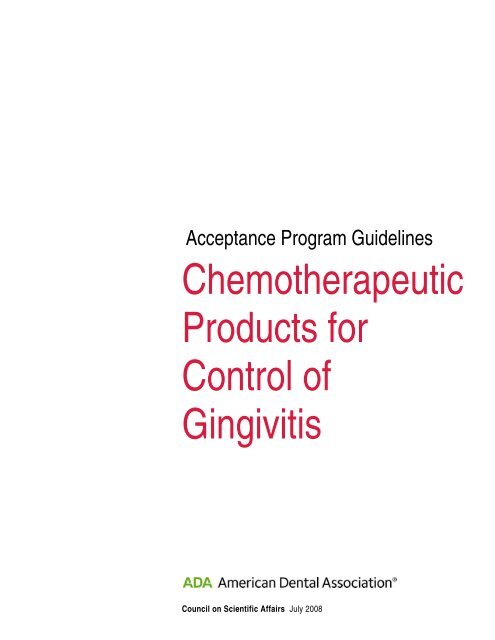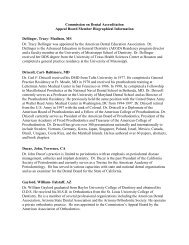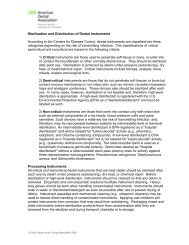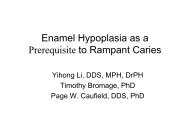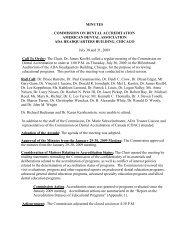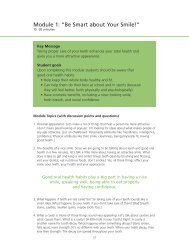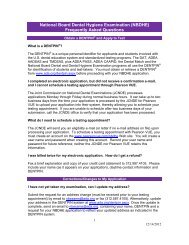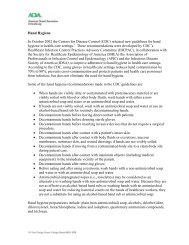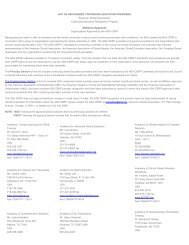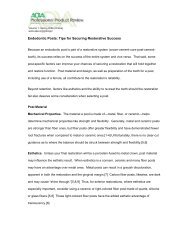Chemotherapeutic Products for the Control of Gingivitis - American ...
Chemotherapeutic Products for the Control of Gingivitis - American ...
Chemotherapeutic Products for the Control of Gingivitis - American ...
Create successful ePaper yourself
Turn your PDF publications into a flip-book with our unique Google optimized e-Paper software.
Acceptance Program Guidelines<br />
<strong>Chemo<strong>the</strong>rapeutic</strong><br />
<strong>Products</strong> <strong>for</strong><br />
<strong>Control</strong> <strong>of</strong><br />
<strong>Gingivitis</strong><br />
Council on Scientific Affairs July 2008
Copyright © 2008 <strong>American</strong> Dental Association. All rights reserved. Any <strong>for</strong>m <strong>of</strong> reproduction is strictly prohibited without prior written permission.
<strong>Chemo<strong>the</strong>rapeutic</strong> <strong>Products</strong> <strong>for</strong> <strong>Control</strong> <strong>of</strong> <strong>Gingivitis</strong>, July 2008<br />
<strong>Chemo<strong>the</strong>rapeutic</strong> <strong>Products</strong><br />
Council on Scientific Affairs <strong>for</strong> <strong>Control</strong> <strong>of</strong> <strong>Gingivitis</strong><br />
Scope: These guidelines apply to products used <strong>for</strong> <strong>the</strong> control <strong>of</strong> gingivitis and, if applicable,<br />
supragingival dental plaque, through <strong>the</strong> use <strong>of</strong> chemo<strong>the</strong>rapeutic agents. <strong>Products</strong> that control<br />
gingivitis solely by <strong>the</strong> mechanical removal <strong>of</strong> plaque will not be considered by <strong>the</strong>se guidelines.<br />
Examples <strong>of</strong> products evaluated under <strong>the</strong>se guidelines include mouthrinses and dentifrices<br />
containing agents that would destroy, inhibit or modify plaque, including its pathogenicity <strong>for</strong><br />
gingivitis, and microbiologic growth in general, those that modify <strong>the</strong> attachment <strong>of</strong> plaque<br />
microorganisms to <strong>the</strong>ir natural sites, and those that act by o<strong>the</strong>r antimicrobial mechanisms to<br />
reduce or prevent gingivitis. All studies conducted to determine ADA Acceptance <strong>of</strong> a particular<br />
product or agent should be registered with <strong>the</strong> ADA in advance, and <strong>the</strong> results <strong>of</strong> all studies<br />
must be reported, with <strong>the</strong> two considered pivotal being properly identified.
2 <strong>Chemo<strong>the</strong>rapeutic</strong> <strong>Products</strong> <strong>for</strong> <strong>Control</strong> <strong>of</strong> <strong>Gingivitis</strong>, July 2008<br />
I. SUBMISSION DIRECTIONS<br />
1. General In<strong>for</strong>mation<br />
A Submissions are to be sent to <strong>the</strong> Council Office:<br />
Director, Acceptance Program<br />
Council on Scientific Affairs<br />
<strong>American</strong> Dental Association<br />
211 East Chicago Avenue<br />
Chicago, Illinois 60611–2678<br />
B Submissions are to be sent in triplicate, along with one single-sided copy <strong>for</strong> duplicating purposes. Three samples<br />
<strong>of</strong> each product from different lots shall be provided. Market samples are preferred. If possible, <strong>the</strong> submission<br />
should be less than 200 pages exclusive <strong>of</strong> appendices.<br />
C A manufacturer is advised that <strong>the</strong> review process is complex. Typically, notification <strong>of</strong> Council action may be<br />
expected 90 to 150 days from <strong>the</strong> receipt <strong>of</strong> a complete submission by <strong>the</strong> Council. More time may be required if<br />
additional in<strong>for</strong>mation or clarification is needed from <strong>the</strong> manufacturer.<br />
D When a product is classified as “Accepted” <strong>the</strong> classification is <strong>for</strong> 3 years. Renewal <strong>of</strong> <strong>the</strong> classification will be<br />
considered by <strong>the</strong> Council upon request by <strong>the</strong> manufacturer.<br />
E Companies with Accepted products are subject to <strong>the</strong> conditions stated in <strong>the</strong> Agreement Governing Use <strong>of</strong> ADA<br />
Seal <strong>of</strong> Acceptance.<br />
2. Arrangement <strong>of</strong> a Submission<br />
A The submission is to be divided into sections and arranged in order as indicated in Part II. Sections to be identified<br />
by tabs are designated by an asterisk (*).
<strong>Chemo<strong>the</strong>rapeutic</strong> <strong>Products</strong> <strong>for</strong> <strong>Control</strong> <strong>of</strong> <strong>Gingivitis</strong>, July 2008 3<br />
II. INFORMATION TO BE SUBMITTED<br />
1. Cover Page<br />
A Name <strong>of</strong> company<br />
B Product name<br />
*2. Table <strong>of</strong> Contents<br />
*3. Company In<strong>for</strong>mation<br />
A Name <strong>of</strong> company (to be used in <strong>of</strong>ficial list <strong>of</strong> Accepted <strong>Products</strong>)<br />
B Address (to be used in listing)<br />
C Phone number (to be used in listing)<br />
D Fax number<br />
E Names <strong>of</strong> owners, <strong>of</strong>ficers and o<strong>the</strong>r individuals authorized to furnish in<strong>for</strong>mation to <strong>the</strong> Council and represent <strong>the</strong><br />
firm in dealing with <strong>the</strong> Council, including <strong>the</strong> main contact person. (Foreign manufacturers must have an <strong>of</strong>fice or<br />
branch located in <strong>the</strong> United States and <strong>the</strong> product must be available <strong>for</strong> purchase in <strong>the</strong> United States.)<br />
F Names and qualifications <strong>of</strong> scientific personnel responsible <strong>for</strong> <strong>for</strong>mulation and testing <strong>of</strong> <strong>the</strong> product.<br />
*4. Summary <strong>of</strong> Submission<br />
Comprehensive summary <strong>of</strong> <strong>the</strong> in<strong>for</strong>mation submitted on safety and effectiveness <strong>of</strong> <strong>the</strong> chemo<strong>the</strong>rapeutic products<br />
used <strong>for</strong> <strong>the</strong> control or modification <strong>of</strong> supragingival dental plaque and gingivitis.<br />
*5. Product In<strong>for</strong>mation<br />
A Name <strong>of</strong> product (to be used in listing)<br />
B Claims <strong>of</strong> efficacy<br />
(i) Evidence <strong>of</strong> FDA approval to market if applicable (e.g., 510 (k) letter, pre-market approval [PMA], NDA). 1<br />
(ii) All claims <strong>of</strong> efficacy, including all health benefit claims, (e.g., gingivitis reduction), and all claims which imply a<br />
health benefit (e.g., plaque reduction) must be documented (see below). These claims include but are not<br />
limited to “reduces plaque/gingivitis,” “prevents plaque/gingivitis,” “fights <strong>the</strong> gum disease gingivitis,” “fights<br />
bleeding gums,” and “reduces swollen gums.”<br />
(iii) Advertisements must avoid disparagement <strong>of</strong> o<strong>the</strong>r products.<br />
(iv) The Council believes that because plaque is <strong>the</strong> etiologic agent <strong>for</strong> gingivitis and o<strong>the</strong>r oral diseases, <strong>the</strong> only<br />
Accepted chemo<strong>the</strong>rapeutic products that will be allowed to make plaque control or plaque modification<br />
claims will be those that can also demonstrate a significant effect against gingivitis. If a product can only<br />
1 This requirement may be waived by <strong>the</strong> Council during <strong>the</strong> evaluation period. Evidence must be provided prior to use <strong>of</strong> <strong>the</strong> ADA Seal if <strong>the</strong><br />
product is accepted.
4 <strong>Chemo<strong>the</strong>rapeutic</strong> <strong>Products</strong> <strong>for</strong> <strong>Control</strong> <strong>of</strong> <strong>Gingivitis</strong>, July 2008<br />
demonstrate a significant plaque reduction without a concomitant significant reduction in gingivitis, it will not<br />
be eligible <strong>for</strong> Acceptance.<br />
C Patent title(s) and patent number(s) relating to <strong>the</strong> product<br />
D Product description<br />
(i) Chemical composition and amounts<br />
E Instructions including indications and contraindications <strong>for</strong> use, warnings etc.<br />
F Labeling/packaging<br />
G Promotional materials<br />
*6. Quality <strong>Control</strong> Procedures <strong>for</strong> <strong>the</strong> Manufacturing <strong>of</strong> <strong>the</strong> Product<br />
This should include <strong>the</strong> Quality <strong>Control</strong> tests used during processing and on <strong>the</strong> finished product, and assurance that<br />
<strong>the</strong> product meets good manufacturing procedures.<br />
*7. Efficacy Data<br />
Product efficacy must be demonstrated by two independent, well-designed, 6-month clinical studies utilizing a placebo<br />
control and conducted by independent investigators. All published studies assessing <strong>the</strong> effectiveness <strong>of</strong> <strong>the</strong> product<br />
must be referenced, including studies that do not show any effect. All proprietary studies, including those that do not<br />
show any effect, must also be provided.<br />
Studies should assess <strong>the</strong> ability <strong>of</strong> a chemo<strong>the</strong>rapeutic agent to prevent or reduce gingivitis and to inhibit or reduce<br />
plaque <strong>for</strong>mation or plaque pathogenicity. Masked studies are required; uniquely labeled products must be used and<br />
group coding must be avoided. At least one study shall be conducted on a US population. Populations selected <strong>for</strong> <strong>the</strong><br />
studies must be representative <strong>of</strong> individuals <strong>for</strong> whom <strong>the</strong> product is intended, which, in most cases, would be<br />
individuals with mild to moderate gingivitis. Trials must report all treatment groups.<br />
A Statistically significant reductions in both <strong>the</strong> clinical manifestations <strong>of</strong> gingivitis and in <strong>the</strong> inhibition or reduction <strong>of</strong><br />
plaque or plaque pathogenicity related to gingivitis must be demonstrated. Reductions relative to plaque and<br />
gingivitis should be demonstrated after 6 months <strong>of</strong> use in two studies and be measured against a placebo control<br />
ra<strong>the</strong>r than baseline scores. The product must show clinical significance (see section C) in gingivitis reduction<br />
compared to placebo controls in at least two clinical studies.<br />
B Microbiological sampling should estimate plaque qualitatively to complement indices that measure plaque<br />
quantitatively.<br />
C <strong>Gingivitis</strong> measurements shall demonstrate:<br />
(i) that <strong>the</strong> estimated proportionate reductions [i.e. (control–active)/control] be no less than 15% in favor <strong>of</strong> <strong>the</strong><br />
active treatment with a confidence interval <strong>of</strong> ± 10%, and statistically significant in each <strong>of</strong> at least two studies;<br />
(ii) that, in addition, <strong>the</strong> (arithmetic) mean <strong>of</strong> <strong>the</strong> estimated proportionate reductions [i.e. (control–active)/control]<br />
across <strong>the</strong> above studies be no less than 20%.<br />
For example, two studies exhibiting statistically significant reductions <strong>of</strong> 20% or more in both indices would meet
<strong>Chemo<strong>the</strong>rapeutic</strong> <strong>Products</strong> <strong>for</strong> <strong>Control</strong> <strong>of</strong> <strong>Gingivitis</strong>, July 2008 5<br />
<strong>the</strong>se criteria, as would two studies with respective statistically significant reductions <strong>of</strong> 27% and 15% <strong>for</strong> <strong>the</strong><br />
selected bleeding index and 17% and 24% <strong>for</strong> <strong>the</strong> Löe–Silness GI. “Proportionate reduction” above refers to a<br />
comparison <strong>of</strong> <strong>the</strong> active <strong>the</strong>rapy to <strong>the</strong> control at <strong>the</strong> end <strong>of</strong> <strong>the</strong> study, ra<strong>the</strong>r than to reductions from an initial<br />
baseline level, and presumes that randomization has produced initially comparable active and control clinical<br />
samples, or that fully appropriate statistical adjustment has been used <strong>for</strong> randomization failures.<br />
D Plaque measurements shall demonstrate that quantitative plaque reductions or reductions in plaque<br />
pathogenicity <strong>for</strong> those products whose antigingivitis action is through plaque reduction or modifications are<br />
statistically significant.<br />
E The most likely mechanism(s) <strong>of</strong> action <strong>of</strong> <strong>the</strong> product should be given, with supporting data.<br />
*8. Safety Data<br />
Data supporting product safety should include clinical studies in which oral s<strong>of</strong>t tissues and teeth are examined and<br />
appropriate toxicological and microbiological studies demonstrating that pathogenic or opportunistic<br />
micro-organisms are not selected <strong>for</strong> over <strong>the</strong> course <strong>of</strong> <strong>the</strong> study.<br />
A Effect on oral s<strong>of</strong>t tissues<br />
Evidence that <strong>the</strong> antigingivitis products do not adversely affect oral s<strong>of</strong>t issues should be provided. Subjects<br />
should be examined in <strong>the</strong> course <strong>of</strong> <strong>the</strong> study <strong>for</strong> <strong>the</strong> presence <strong>of</strong> pathologic conditions such as oral ulceration,<br />
candidiasis, or o<strong>the</strong>r secondary infections <strong>of</strong> <strong>the</strong> oral mucosa that may be manifestations <strong>of</strong> <strong>the</strong> proliferation <strong>of</strong><br />
opportunistic microorganisms.<br />
B Effect on teeth<br />
Evidence <strong>of</strong> <strong>the</strong> lack <strong>of</strong> effects <strong>of</strong> antigingivitis products on teeth should be provided.<br />
C Toxicology<br />
In<strong>for</strong>mation submitted <strong>for</strong> products containing chemo<strong>the</strong>rapeutic agents shall include assessments <strong>of</strong> possible<br />
toxic effects <strong>of</strong> <strong>the</strong> active agent or adverse effects <strong>of</strong> <strong>the</strong> product <strong>for</strong>mulation. These should include standard<br />
toxicological pr<strong>of</strong>iles depending on <strong>the</strong> particular product. All products must submit data on <strong>the</strong> mutagenicity and<br />
<strong>the</strong> carcinogenicity <strong>of</strong> <strong>the</strong> product or its active agents. It is also recommended that data be provided on <strong>the</strong> effect<br />
<strong>of</strong> <strong>the</strong> product, if any, on taste sensation, staining <strong>of</strong> oral tissue, or o<strong>the</strong>r characteristics that may be unique to<br />
<strong>the</strong> active <strong>for</strong>mulation.<br />
D Microbiology<br />
Evidence <strong>of</strong> <strong>the</strong> effects on oral flora should be provided from at least one study. Oral flora should be monitored<br />
in subjects during <strong>the</strong> study <strong>for</strong> <strong>the</strong> development <strong>of</strong> opportunistic and pathogenic organisms. Evidence must be<br />
provided that oral flora has not been adversely affected. Microbiological data can be obtained from a subset <strong>of</strong><br />
subjects.<br />
*9. Comprehensive Bibliography<br />
*10. Copies <strong>of</strong> Most Significant Articles<br />
*11. Appendices<br />
Detailed description <strong>of</strong> test evaluation methods and any o<strong>the</strong>r defined areas.
6 <strong>Chemo<strong>the</strong>rapeutic</strong> <strong>Products</strong> <strong>for</strong> <strong>Control</strong> <strong>of</strong> <strong>Gingivitis</strong>, July 2008<br />
III. STATEMENTS TO BE USED FOR PRODUCTS CLASSIFIED UNDER THESE<br />
GUIDELINES INCLUDING QUALIFIERS<br />
There will be two Seal statements to be used with an Accepted product, depending on whe<strong>the</strong>r or not <strong>the</strong> product’s<br />
mechanism <strong>of</strong> action is related to plaque reduction. The Seal statement may be modified to include o<strong>the</strong>r accepted<br />
indications.<br />
Statement 1: For Both <strong>Gingivitis</strong> and Plaque Reduction<br />
“[Product Name] has been shown to help prevent and reduce [whichever is appropriate] gingivitis and supragingival<br />
plaque accumulation when used as directed in a conscientiously applied program <strong>of</strong> oral hygiene and regular pr<strong>of</strong>essional<br />
care. Its effect on periodontitis has not been determined.” Council on Scientific Affairs, ADA.<br />
Statement 2: For <strong>Gingivitis</strong> Reduction Only<br />
“[Product Name] has been shown to help prevent and reduce [whichever is appropriate] gingivitis when used as directed<br />
in a conscientiously applied program <strong>of</strong> oral hygiene and regular pr<strong>of</strong>essional care. Its effect on periodontitis has not been<br />
determined.” Council on Scientific Affairs, ADA.
<strong>Chemo<strong>the</strong>rapeutic</strong> <strong>Products</strong> <strong>for</strong> <strong>Control</strong> <strong>of</strong> <strong>Gingivitis</strong>, July 2008 7<br />
IV. REFERENCES FOR FURTHER EXPLANATION<br />
The following references were used in <strong>the</strong> development <strong>of</strong> <strong>the</strong>se Guidelines. They can be consulted <strong>for</strong> a more detailed<br />
discussion <strong>of</strong> issues addressed in <strong>the</strong>se Guidelines.<br />
A Council on Dental Therapeutics Guidelines <strong>for</strong> Acceptance <strong>of</strong> <strong>Chemo<strong>the</strong>rapeutic</strong> <strong>Products</strong> <strong>for</strong> <strong>the</strong> <strong>Control</strong> <strong>of</strong><br />
Supragingival Plaque and <strong>Gingivitis</strong>. J Am. Dent. Assoc 1986; 112:529–532.<br />
B Recommended Revisions to <strong>American</strong> Dental Association Guidelines <strong>for</strong> Acceptance <strong>of</strong> <strong>Chemo<strong>the</strong>rapeutic</strong> <strong>Products</strong><br />
<strong>for</strong> <strong>Gingivitis</strong> <strong>Control</strong>. J Periodont Res 1994; 29:299–304.<br />
C ADA Council on Scientific Affairs. Acceptance Program Guidelines <strong>for</strong> Clinical Trial Protocols. Chicago: <strong>American</strong><br />
Dental Association, 2007.
8 <strong>Chemo<strong>the</strong>rapeutic</strong> <strong>Products</strong> <strong>for</strong> <strong>Control</strong> <strong>of</strong> <strong>Gingivitis</strong>, July 2008<br />
CLINICAL PROTOCOL GUIDELINES<br />
The following guidelines are given <strong>for</strong> <strong>the</strong> design and conduct <strong>of</strong> clinical studies <strong>for</strong> <strong>the</strong> evaluation <strong>of</strong> chemo<strong>the</strong>rapeutic agents to<br />
provide evidence <strong>of</strong> effectiveness and safety in <strong>the</strong> control <strong>of</strong> gingivitis and, if applicable, supragingival plaque. Additional<br />
in<strong>for</strong>mation regarding clinical trials and clinical trial reporting can be obtained from <strong>the</strong> Council’s Guidelines <strong>for</strong> Clinical Trial<br />
Protocols (see References). The clinical benefit <strong>of</strong> plaque control can best be demonstrated by a significant reduction in<br />
gingivitis. For products that accomplish <strong>the</strong>ir antigingivitis effectiveness through plaque reduction, it will be necessary to<br />
demonstrate statistically significant reductions in both plaque and gingivitis by <strong>the</strong> products. For products that do not exert <strong>the</strong>ir<br />
antigingivitis effect through plaque reduction, it will be necessary to demonstrate a statistically significant reduction in gingivitis<br />
and supporting data <strong>for</strong> <strong>the</strong> mechanism <strong>of</strong> action. In each study, <strong>the</strong> active product should be compared with a placebo control. In<br />
addition, a positive control may be added. Designs employing ei<strong>the</strong>r crossover or parallel groups are acceptable. Because <strong>of</strong> a<br />
possible retained effect <strong>of</strong> some agents, care must be taken in a crossover design to include an adequate latent period between<br />
study periods. Additionally, <strong>the</strong> crossover design may not be practical in <strong>the</strong> long-term studies required <strong>for</strong> adequate evaluation<br />
<strong>of</strong> product efficacy. When <strong>the</strong> indices used allow accurate repeated measures, it is necessary to provide a measure <strong>of</strong> intra- and<br />
inter-evaluator variance. Examiners should be capable, at a minimum, <strong>of</strong> replicating <strong>the</strong>ir own scores to a high degree on a siteby-site<br />
basis. A Kappa statistic <strong>of</strong> 0.6 would indi-cate satisfactory calibration <strong>for</strong> gingivitis. An attempt should be made to assess<br />
<strong>the</strong> level <strong>of</strong> compliance <strong>of</strong> <strong>the</strong> subjects in <strong>the</strong> study. Manufacturers are encouraged to submit <strong>the</strong>ir clinical protocols to <strong>the</strong><br />
Council <strong>for</strong> review prior to <strong>the</strong> start <strong>of</strong> clinical studies.<br />
Sample Size<br />
A sufficient number <strong>of</strong> subjects should be enrolled in <strong>the</strong> study to ensure that appropriate statistical tests can be per<strong>for</strong>med.<br />
Study Duration<br />
The studies will be conducted <strong>for</strong> a minimum <strong>of</strong> 6 months. Measurements will be taken at least at baseline (prior to <strong>the</strong> study), at<br />
6 months, and at an intermediate period.<br />
Study Design<br />
Each subject will have a complete oral cavity examination to determine eligibility <strong>for</strong> <strong>the</strong> study. Studies should be conducted with<br />
populations and under conditions that <strong>the</strong> product is expected to be used. Both genders should normally participate; <strong>the</strong> age <strong>of</strong><br />
<strong>the</strong> study populations and <strong>the</strong> levels <strong>of</strong> gingivitis should be representative <strong>of</strong> those patients <strong>for</strong> whom <strong>the</strong> product is intended; <strong>the</strong><br />
frequency <strong>of</strong> use <strong>of</strong> <strong>the</strong> product should be representative <strong>of</strong> actual use <strong>of</strong> <strong>the</strong> product in practice; and <strong>the</strong> user should be<br />
instructed in <strong>the</strong> proper use <strong>of</strong> <strong>the</strong> product but not necessarily supervised. Subjects should not be taking medication which alters<br />
gingival appearance/bleeding. Also <strong>the</strong>y should not have taken such medications within one month <strong>of</strong> initiation <strong>of</strong> <strong>the</strong> study.<br />
O<strong>the</strong>r criteria <strong>for</strong> inclusion/exclusion <strong>of</strong> subjects must be provided.<br />
If a protocol is designed to test a product to be used <strong>for</strong> a specific indication where a pre-prophylaxis baseline is not required, <strong>for</strong><br />
example, a reduction in existing gingivitis claim, appropriate modifications should be made in <strong>the</strong> study.<br />
Efficacy Assessments<br />
A Plaque Assessments<br />
Plaque area will be determined at each examination using a well-recognized plaque index, e.g., Turesky et al. (J Periodont<br />
1970; 41:41). Justification <strong>for</strong> <strong>the</strong> particular plaque index used must be provided. Measurements <strong>of</strong> plaque pathogenicity, if<br />
applicable to <strong>the</strong> product’s mechanism <strong>of</strong> action, will be determined.<br />
B <strong>Gingivitis</strong> Assessments
<strong>Chemo<strong>the</strong>rapeutic</strong> <strong>Products</strong> <strong>for</strong> <strong>Control</strong> <strong>of</strong> <strong>Gingivitis</strong>, July 2008 9<br />
Methods should be selected that measure gingivitis using both subjective and objective criteria. That is, gingivitis will be<br />
evaluated using an index <strong>of</strong> gingival bleeding (e.g., Eastman Interdental Bleeding Index), coupled with ei<strong>the</strong>r a purely visuallybased<br />
gingivitis index or, alternately, a comprehensive gingivitis index which incor-porates both bleeding and visual<br />
appearance, e.g., Löe & Silness (Acta Odon 1963 21:533). O<strong>the</strong>r indices in addition to those mentioned above that have<br />
been shown to measure gingival health may also be used. Justification <strong>for</strong> <strong>the</strong> particular gingival indices used must be<br />
provided.<br />
The gingival indices used should be simple to use with a minimum <strong>of</strong> time and expense; criteria <strong>for</strong> assessing <strong>the</strong> stages <strong>of</strong><br />
gingivitis should be clear and understandable; <strong>the</strong> clinical manifestations <strong>of</strong> <strong>the</strong> disease process should be measurable at all<br />
stages; and <strong>the</strong> data from <strong>the</strong> index should be amenable to statistical treatment. Accurate indices should be used to assess<br />
<strong>the</strong> proper severity <strong>of</strong> <strong>the</strong> condition and <strong>the</strong> localized effects <strong>of</strong> treatment.<br />
C Statistical Analysis<br />
Mean group whole mouth scores <strong>for</strong> plaque and gingivitis on all surfaces will be compared at baseline, 6 months, and at an<br />
intermediate period with appropriate statistical tests in at least one study. Ramfjord teeth may be used <strong>for</strong> any additional<br />
studies. If more than two groups are being evaluated appropriate multiple comparison tests should be used. The basis <strong>for</strong><br />
statistical sizing must be provided in <strong>the</strong> protocol. In<strong>for</strong>mation to be provided includes expected examiner variance, <strong>the</strong><br />
targeted alpha and beta values, <strong>the</strong> estimated drop out rate, and <strong>the</strong> targeted treatment differences.<br />
Basic documentation should include summary statistics <strong>of</strong> outcomes and potentially important prognostic variables, by<br />
treatment. In multi-center trials, <strong>the</strong>se should be reported separately <strong>for</strong> each participating center, as well as <strong>for</strong> all centers<br />
combined.<br />
If <strong>the</strong> trial employs stratified randomization in <strong>the</strong> design, <strong>the</strong> analysis should reflect this. The distributions <strong>of</strong> important<br />
prognostic factors should be compared across treatment groups, and statistical adjustment employed where disparities in<br />
prognostic variables may have seriously influenced outcome comparisons. In multi-centered trials, <strong>the</strong> possibility and nature<br />
<strong>of</strong> treatment by center interactions should be examined. Among many possible technical approaches to statistical analysis,<br />
analyses <strong>of</strong> variance or covariance, original categorical analyses, and rank analyses are typically considered. Mention <strong>of</strong><br />
<strong>the</strong>se approaches by no means precludes use <strong>of</strong> o<strong>the</strong>r techniques as appropriate to <strong>the</strong> study design and variables<br />
employed. Although whole-mouth mean scores are traditionally used in <strong>the</strong> primary analyses <strong>of</strong> gingivitis trials, site-specific<br />
data (e.g., from <strong>the</strong> interdental papillae) may provide additional in<strong>for</strong>mation <strong>of</strong> special clinical relevance <strong>for</strong> some products, in<br />
which case <strong>the</strong>y may also be tracked and suitably analyzed. Analyses <strong>of</strong> separate observations at individual sites should<br />
appropriately account <strong>for</strong> correlations <strong>of</strong> site-based measurements within <strong>the</strong> same subject.<br />
Safety Assessments<br />
A Oral S<strong>of</strong>t Tissue Assessment<br />
Refer to Section 8 a. Safety assessments must be made at each measurement period.<br />
B Oral Hard Tissue Assessment<br />
Refer to Section 8 b. Safety assessments must be made at each measurement period.<br />
C Toxicology Assessment<br />
Refer to Section 8 c.
10 <strong>Chemo<strong>the</strong>rapeutic</strong> <strong>Products</strong> <strong>for</strong> <strong>Control</strong> <strong>of</strong> <strong>Gingivitis</strong>, July 2008<br />
D Microbiological Assessment<br />
The objective <strong>of</strong> <strong>the</strong> microbial assessment <strong>of</strong> plaque is to determine whe<strong>the</strong>r <strong>the</strong>re are shifts in <strong>the</strong> balance <strong>of</strong> flora that might<br />
have an adverse effect on oral tissues, or contribute to <strong>the</strong> progression <strong>of</strong> microorganisms in <strong>the</strong> flora <strong>for</strong>m non-periodontal<br />
pathogens to those that are pathogenic. Evidence should be provided that <strong>the</strong> development <strong>of</strong> resistant microorganisms does<br />
not occur with use <strong>of</strong> <strong>the</strong> product.<br />
Plaque should be harvested in such a way from <strong>the</strong> areas chosen <strong>for</strong> sampling that an objective evaluation <strong>of</strong> <strong>the</strong> flora can be<br />
made. It is suggested that <strong>the</strong> sample be recorded as recoverable counts per representative pooled plaque sample from <strong>the</strong><br />
individual. Methods that require that total plaque be harvested from each area chosen <strong>for</strong> sampling and counts recorded as<br />
ei<strong>the</strong>r counts per tooth or counts per milligram <strong>of</strong> wet plaque weights are acceptable as an additional method <strong>of</strong><br />
documentation.<br />
Microbiological plaque samplings should be incorporated into <strong>the</strong> design <strong>of</strong> <strong>the</strong> study and taken at <strong>the</strong> two time intervals <strong>for</strong><br />
control and test groups, i.e., <strong>the</strong> beginning and end <strong>of</strong> study. It is recommended, but not required, that consideration be given<br />
to include a microbiological assessment <strong>of</strong> post-treatment plaque in <strong>the</strong> study design. A subset <strong>of</strong> <strong>the</strong> participants would be<br />
acceptable <strong>for</strong> samplings at selected time periods.<br />
(i) Resistance <strong>of</strong> microorganisms<br />
This can be evaluated by assessing <strong>the</strong> minimum inhibitory concentration (MIC) <strong>of</strong> representative oral microorganisms.<br />
(ii) Estimates <strong>of</strong> total plaque bacteria<br />
Plaque samples <strong>of</strong> a subset representative <strong>of</strong> <strong>the</strong> population in <strong>the</strong> study should be collected and grown in a nonselective<br />
medium. A count <strong>of</strong> bacteria should be made to estimate total bacterial load.<br />
(iii) Estimates <strong>of</strong> representative plaque bacteria<br />
Plaque samples should be grown on media selective <strong>for</strong> appropriate representative groups <strong>of</strong> microorganisms. The use <strong>of</strong><br />
dark-field or phase contrast microscopy would be an additional method suitable <strong>for</strong> identifying motile <strong>for</strong>ms. A count and<br />
microscopic analysis should be made to estimate plaque content <strong>of</strong> representative populations <strong>of</strong> microorganisms that are<br />
normally found in plaque or are associated with gingivitis.<br />
The data should clearly characterize <strong>the</strong> oral flora in <strong>the</strong> control group compared with <strong>the</strong> test group in terms <strong>of</strong> normal<br />
populations identified in supragingival plaque. Long-term studies with antimicrobial agents should demonstrate that<br />
although a shift or change in <strong>the</strong> species <strong>of</strong> <strong>the</strong>se bacteria may occur, a shift to predominately gram-negative, anaerobic,<br />
and motile <strong>for</strong>ms should not occur. It shall be demonstrated that microorganisms that have been associated with<br />
periodontitis do not develop supragingivally during <strong>the</strong> course <strong>of</strong> a clinical study. Opportunistic organisms such as yeasts<br />
and gram-negative enteric bacteria shall also not develop during <strong>the</strong> study.<br />
ADDENDUM 1<br />
A Council on Dental Therapeutics Guidelines <strong>for</strong> Acceptance <strong>of</strong> <strong>Chemo<strong>the</strong>rapeutic</strong> <strong>Products</strong> <strong>for</strong> <strong>the</strong> <strong>Control</strong> <strong>of</strong> Supragingival<br />
Plaque and <strong>Gingivitis</strong>. J Am Dent Assoc 1986; 112: 529-532.<br />
ADDENDUM 2<br />
A Recommended Revisions to <strong>American</strong> Dental Association Guidelines <strong>for</strong> Acceptance <strong>of</strong> <strong>Chemo<strong>the</strong>rapeutic</strong> <strong>Products</strong> <strong>for</strong><br />
<strong>Gingivitis</strong> <strong>Control</strong>. J Periodont Res 1994; 29: 299-304.
211 East Chicago Avenue, Chicago, IL 60611


